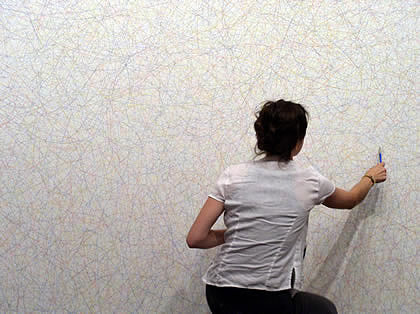None of these examples are software based…to prove a point:
Mark Lombardi
Mark Lombardi was not a digital artists, but his work is the reason i first became interested in data visualization. Lombardi was an art historian/researcher who diagrammed complex networks of events (political, conspiratorial, etc). Lombardi’s work is special in (a) the thoroughness of his research and (b) the fact that it distills complex networks into visually beautiful/legible schemes.
Here’s a link to a 2003 NPR interview about Lombardi.
Sol Lewitt wall drawings
Sol Lewitt’s wall drawing aren’t info-viz in the sense a traditional pipe-a-bunch-of-data-into-a-computer-and-make-pretty way, but they are the the result of the execution of an algorithmic/generative process of instruction following/code execution to visually represent a series of instructions which serve as both code and data. A example of these instructions from Wall Drawing 118:
On a wall surface, any
continuous stretch of wall,
using a hard pencil, place
fifty points at random.
The points should be evenly
distributed over the area
of the wall. All of the
points should be connected
by straight lines
xkcd: money
I’m putting Randall Munroe in rarified company here, but this is one of the best info-vis projects I’ve seen in along time. Again, it’s simply rendered, but it’s the research that makes it so staggering as an object. It’s immediate, compelling, and works across a number of scales. I’d love to see it outside of a computer window and in print. Link.

